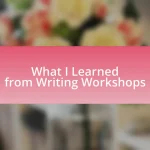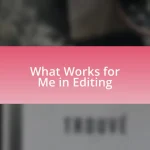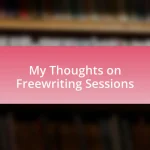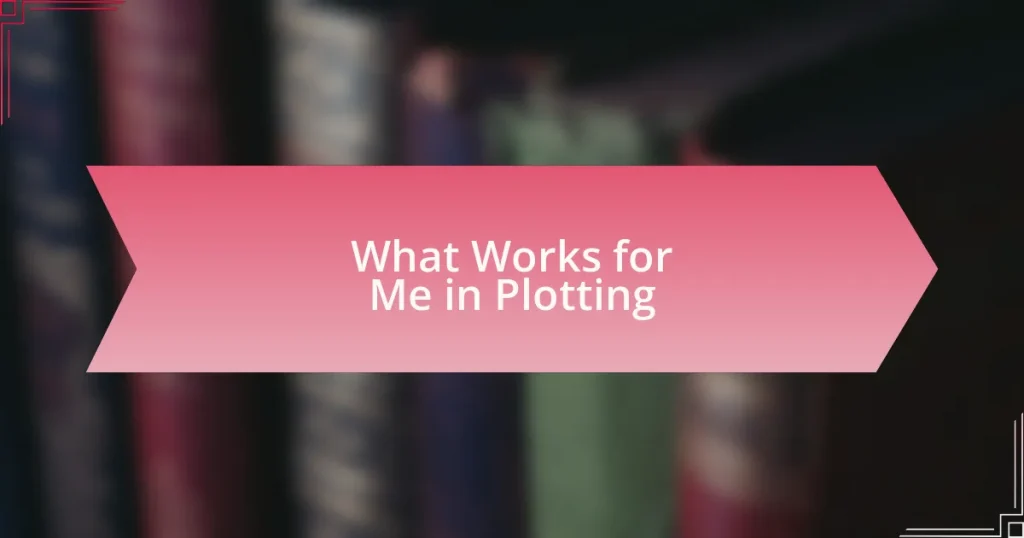Key takeaways:
- Clara Whitfield emphasizes the importance of narrative structure, particularly the three-act structure, for creating engaging and clear stories.
- She discusses common plotting challenges, such as maintaining consistent pacing and avoiding predictability, and highlights the need for strong character motivations.
- Effective strategies include outlining, using subplots to enrich the main narrative, and incorporating feedback from beta readers to enhance the plot.
- Flexibility in plotting is crucial, as characters may lead the story in unexpected directions, enriching the narrative and reader experience.
Author: Clara Whitfield
Bio: Clara Whitfield is a captivating storyteller and acclaimed author known for her rich, character-driven narratives that explore the complexities of human relationships. With a background in psychology and a passion for literature, Clara weaves intricate plots that resonate with readers on multiple levels. Her debut novel, “Echoes of the Heart,” received critical acclaim and was a finalist for several literary awards. When she’s not writing, Clara enjoys hiking in nature, experimenting in the kitchen, and engaging with her vibrant community of fellow writers. She resides in Portland, Oregon, where she draws inspiration from the lush surroundings and eclectic culture.
Understanding Plotting Techniques
One plotting technique that I find particularly effective is the three-act structure. This approach breaks a story into a setup, confrontation, and resolution. When I first used this method in my writing, I discovered that having a clear beginning, middle, and end not only made my narrative flow better but also kept readers engaged throughout. Isn’t it fascinating how a simple framework can elevate a story?
Another technique that resonates with me is mind mapping. I remember sitting at my kitchen table, spreading out index cards to visualize my ideas. This method allowed me to explore connections between characters and plot points that I might have overlooked otherwise. Have you ever had that a-ha moment when everything just clicks into place? That’s the magic of mind mapping.
Lastly, I often turn to character-driven plotting. Instead of forcing the plot to dictate character actions, I’ve found that letting my characters lead the way creates more authentic and emotionally invested narratives. When I let my characters act based on their fears and desires, I find that the plot unfolds organically, which feels so much more real. What about you—do you prefer a plot that shapes your characters, or do you let your characters shape the plot?
Importance of Plot Structure
Plot structure is crucial because it serves as the backbone of any narrative. I remember when I first attempted to write without much planning; the result felt like a chaotic jumble of events. It wasn’t until I began to respect the framework of plot structure that my stories gained clarity and purpose. Have you noticed how a well-structured plot can grip the reader’s attention and keep them turning pages?
Moreover, a coherent plot structure helps to build suspense and anticipation. When I strategically placed cliffhangers at the end of chapters, I saw the excitement in my readers’ eyes. It’s a delightful feeling to know that your structure has led them to want more, pushing them to read just one more chapter. Isn’t there something invigorating about that push and pull in storytelling?
Finally, plot structure allows for the development of themes and character arcs. I’ve realized that when I weave my characters’ journeys into a well-defined structure, the messages I want to convey resonate more deeply. A strong plot not only entertains but also communicates meaning—what themes have you found emerge from your stories as you work on the structure?
Common Plotting Challenges
Plotting can often feel like navigating a maze, and one of the most common challenges is maintaining consistent pacing. I recall a time when I got too caught up in intricate details, causing my story to drag in places. Readers often lose interest during slow stretches, so finding that sweet spot between action and reflection is essential for keeping their engagement alive. Have you ever felt frustrated trying to balance these elements?
Another hurdle many writers face is the fear of predictability. It’s tempting to lean on familiar tropes, but I’ve learned that while they can provide structure, they might also lead to unoriginal plots. I remember experimenting with unexpected twists; they surprised not only my readers but me as well. Have you tried stepping outside your comfort zone in your storytelling?
Finally, ensuring character motivations remain clear throughout the plot can be quite challenging. There were times when I thought my characters’ actions were obvious, only to find that readers were confused along the way. Crafting authentic motivations can deepen the plot and connect readers to the characters. When was the last time you had to rethink a character’s drive to make your story stronger?
Effective Plotting Strategies
Effective Plotting Strategies
One effective strategy I’ve adopted is the use of outlines. Initially, I resisted structuring my stories this way, thinking it would stifle my creativity. However, I’ve found that outlining actually helps me clarify my thoughts and maintain direction, allowing me to focus on character development and world-building without getting lost in the chaos. Have you ever tried drafting an outline only to realize how much it enhances your flow?
Another tactic that works wonders is the incorporation of subplots. I recall weaving a subplot around a secondary character that not only offered insight into the main narrative but also enriched the overall emotional stakes. This added layer created an opportunity for deeper exploration of themes, enhancing the main story. It’s fascinating to observe how well-thought-out subplots can elevate the “heart” of a story; have you explored the potential of your characters’ secondary arcs?
Lastly, I prioritize feedback from beta readers or critique partners. Sharing my draft with others often reveals blind spots I hadn’t noticed. There was a time when my pacing felt perfect to me, but others pointed out slow sections that needed tightening. Engaging with readers early can provide invaluable perspectives that sharpen your plot. How do you incorporate feedback into your drafting process?
Personal Insights on Plotting
When it comes to plotting, I find that character motivations are the heartbeat of my stories. I remember a time when I meticulously planned a plot, only to realize the central character’s goal felt hollow. After some reflection, I delved deeper into their backstory and desires, reshaping the plot to create a rich tapestry of drama and urgency. Have you ever discovered a character’s secret that changed your entire story arc?
In my experience, visual aids like storyboards can really bring a plot to life. I once sketched out a series of sticky notes on a wall, each representing a chapter. The act of physically moving them around sparked connections I hadn’t considered before. It’s amazing how the visual element can transform abstract ideas into something tangible; have you experimented with visual strategies yourself?
Also, I’ve learned the power of letting my plot breathe. Early on, I was fixated on hitting specific plot points in a rigid manner. However, allowing moments of stillness—breathable scenes where characters can reflect—has added layers of depth. It invites readers into the emotional core of the story. Have you allowed your narrative space to unfold naturally?
Tools I Use for Plotting
When it comes to the tools I use for plotting, I find that software like Scrivener has been invaluable. It allows me to organize ideas, chapters, and character arcs all in one place. I remember a time when I was juggling multiple timelines and switching between notes and documents, which was quite chaotic. Scrivener’s corkboard feature became a game-changer for me, making it easier to visualize how everything fits together. Have you ever felt overwhelmed by the sheer volume of your ideas?
I also rely heavily on mind mapping tools such as XMind or MindMeister. These platforms help me brainstorm without getting bogged down in linear thinking. I’ve had moments where one small idea blossomed into an entire subplot, and the mind map helped me see those connections clearly. It’s like untangling a web—where does it all lead? When was the last time you mapped out your thoughts to see a bigger picture?
Lastly, I cherish the old-fashioned method of using notebooks for free writing. There’s something liberating about letting my pen flow on paper without constraints. One time, I wrote a stream-of-consciousness narrative that seemed disjointed at first, but later revealed a hidden theme that became the backbone of my plot. Do you ever find clarity through the simple act of writing without limits?
Lessons Learned from Plotting
Plotting teaches me the value of flexibility. While I often plot meticulously, I’ve learned that sometimes characters take unexpected paths. This revelation struck me during a recent project when a minor character I planned to write off suddenly demanded more attention. I had to pivot, and that change not only enriched the story but also reminded me that narratives can surprise even their creators.
Through plotting, I’ve also discovered the importance of character motivation. It became clear to me that a well-defined goal for each character drives the plot forward. When I was drafting a character who felt aimless, the story lost energy and direction. But once I infused that character with a clear desire, the narrative selected its own momentum, pushing both me and the reader forward. Have you ever noticed how the clarity of a character’s intention can transform your writing?
Finally, the act of plotting has made me appreciate the power of pacing. I recall feeling frustrated with a flat section of a manuscript until I painstakingly adjusted the rhythm of actions and emotions. Adding tension in some spots while slowing down for emotional reflection elsewhere entirely changed the reader’s engagement. It was an eye-opening experience that highlighted how nuanced pacing can lead to a more captivating and immersive story. Have you explored how pacing impacts your narrative flow?












